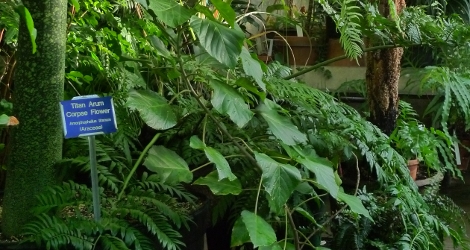Accession Data:
Brugmansia suaveolens (Humb. & Bonpl.) Bercht. & J. Presl.
- Common Name: Angels Trumpet
- Family: Solanaceae Juss.
- Country of Origin: southeast Brazil
- Habitat: cultivated & naturalized at low elevations in tropics
- Description: [syn. Datura Gardneri Hook.f.]
Shrub or small tree, 6-15 feet, glabrous to minutely pubescent; leaves ovate to narrowly elliptic, entire; flowers large, 8-12 inches long, odding but not completely pendulous, calyx 2-5 toothed, slightly inflated, persistent and generally enclosing the fruit; corolla white, more campanulate than trumpet shaped, constricted for a short distance beyond the calyx, teeth 1.5 inches long or less, flaring but not recurved, anthers connivent; fruit fusiform, 4-6 inches long, somewhat rugose.
There are no herbarium collections of any species of this genus made from confirmed wild plants. No botanist specialising in this genus has ever reported seeing wild plants of any species. (Verbal) Reports by non-specialist botanists of the occurrence of ‘wild’ plants are either misidentifications (usually of Datura), or misinterpretation of remnants or localised escapes from cultivation, usually along creeks and occurring by vegetative propagation from stem fragments. In all such instances investigated in Ecuador and Colombia, the plants are of the anthropogenic hybrid Brugmansia x candida (Hay et al. 2012: 172-177). It is quite clear that such instances do not represent self-sustaining sexually reproducing populations.3
The complete lack of evidence of fruit dispersal or spontaneous seedlings, combined with the presence of large numbers of fruits containing viable seed, suggests their dispersers are extinct. Hence, all the species should best be regarded as extinct in the wild.3
- Uses: Principal active biochemicals are the tropane alkaloids hyoscyamine, atropine, and scopolamine. The seeds of Brugmansia contain the highest concentration of alkaloids.
- USDA Zone: 10b
Accession Data:
- Accession # 199200529
- Source: Unknown
- Accession Date: 12-31-1992
- Bench: 1319 - NEOA: South Bench W
- Currently: active - healthy
- Qty: 1 confirmed on 03-25-2025
- Restrictions:
- Poisonous Plant Parts - Not for Human Consumption
Tropane alkaloids. These plants may cause serious illness or death. If ingested, immediately call the Poison Control Center - IUCN Red List: Endangered Species - Extinct in the Wild
- Poisonous Plant Parts - Not for Human Consumption
Classification:
- Division: Magnoliophyta
- Class: Magnoliopsida
- SubClass: euasterid I
- Order: Solanales
- SubOrder:
- Family: Solanaceae
- SubFamily: Solanoideae
- Tribe: Datureae
- SubTribe:
Flowering Data:
This accession has been observed in bloom on:| Year | Jan | Feb | Mar | Apr | May | Jun | Jul | Aug | Sep | Oct | Nov | Dec | ||||||||||||||||||||||||||||||||||||||||
|---|---|---|---|---|---|---|---|---|---|---|---|---|---|---|---|---|---|---|---|---|---|---|---|---|---|---|---|---|---|---|---|---|---|---|---|---|---|---|---|---|---|---|---|---|---|---|---|---|---|---|---|---|
| 2025 | ||||||||||||||||||||||||||||||||||||||||||||||||||||
| 2024 | ||||||||||||||||||||||||||||||||||||||||||||||||||||
| 2023 | ||||||||||||||||||||||||||||||||||||||||||||||||||||
| 2022 | ||||||||||||||||||||||||||||||||||||||||||||||||||||
| 2021 | ||||||||||||||||||||||||||||||||||||||||||||||||||||
| 2020 | ||||||||||||||||||||||||||||||||||||||||||||||||||||
| 2019 | ||||||||||||||||||||||||||||||||||||||||||||||||||||
| 2018 | ||||||||||||||||||||||||||||||||||||||||||||||||||||
| 2017 | ||||||||||||||||||||||||||||||||||||||||||||||||||||
| 2016 | ||||||||||||||||||||||||||||||||||||||||||||||||||||
| 2015 | ||||||||||||||||||||||||||||||||||||||||||||||||||||
| 2014 | ||||||||||||||||||||||||||||||||||||||||||||||||||||
| 2013 | ||||||||||||||||||||||||||||||||||||||||||||||||||||
| 2012 | ||||||||||||||||||||||||||||||||||||||||||||||||||||
| 2011 | ||||||||||||||||||||||||||||||||||||||||||||||||||||
| 2010 | ||||||||||||||||||||||||||||||||||||||||||||||||||||
| 2009 | ||||||||||||||||||||||||||||||||||||||||||||||||||||
| 2008 | ||||||||||||||||||||||||||||||||||||||||||||||||||||
| 2007 | ||||||||||||||||||||||||||||||||||||||||||||||||||||
| 2006 | ||||||||||||||||||||||||||||||||||||||||||||||||||||
| 2005 | ||||||||||||||||||||||||||||||||||||||||||||||||||||
| 2004 | ||||||||||||||||||||||||||||||||||||||||||||||||||||
| 2003 | ||||||||||||||||||||||||||||||||||||||||||||||||||||
References (internal):
- EEB 3271 - Systematic Botany
- EEB 3203 - Developmental Plant Morphology
- IUCN Redlist Extinct in the Wild
References (external):
- The Plant List (2013). Version 1.1. Last accessed on Friday, May 18, 2018.
- Hortus Third, LH Bailey Hortorium, 1976
- Brugmansia suaveolens at IUCN Redlist. Last accessed on Thursday, December 15, 2016.
- Poisonous Plants at University of California. Last accessed on Wednesday, July 05, 2017.
data regenerated on Wed, 14 May 2025 10:27:36 -0400 [bcm v4.0]
Images:

Additional images for this accession:
Click on thumbnails to enlargeCurrent Accessions in the Solanaceae
Subfamily Browallioideae
Tribe Cestreae
Subfamily Nicotianoideae
Subfamily Petunioideae
Subfamily Solanoideae
Subfamily Solanoideae
Tribe Capsiceae
Subfamily Solanoideae
Tribe Datureae
Subfamily Solanoideae
Tribe Hyoscyameae
Subfamily Solanoideae
Tribe Juanulloeae
Subfamily Solanoideae
Tribe Lycieae
Subfamily Solanoideae
Tribe Physaleae
- Iochrominae: Iochroma cyaneum Royal Blue


- Iochrominae: Iochroma fuchsioides

- Withaninae: Withania riebeckii W/C

- Withaninae: Withania somnifera


Subfamily Solanoideae
Tribe Solaneae
- Jaltomata quipuscoae


- Solanum conocarpum

- Solanum conocarpum

- Solanum ensifolium


- Solanum ensifolium W/C


- Solanum seaforthianum

- Solanum wendlandii

 = indicates flowering in past 14 days
= indicates flowering in past 14 days
 = images available for this accession
= images available for this accession
 = map available for this accession
= map available for this accession
 = accession added within past 90 days
= accession added within past 90 days